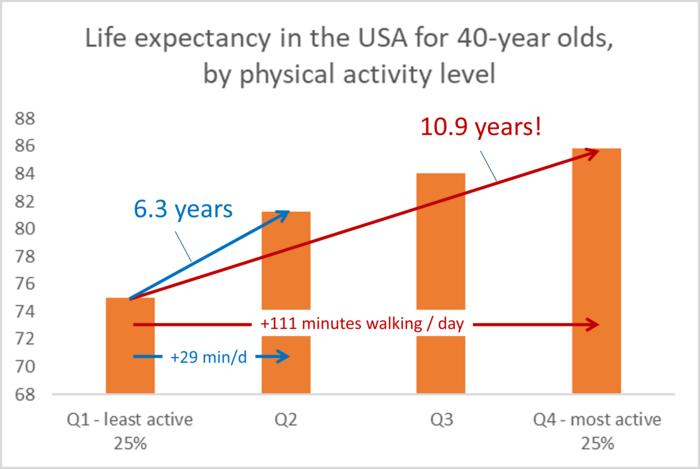A new analysis of physical activity data reveals that Americans over 40 could add more than five years to their lives by matching the activity levels of their most active peers, with the least active individuals standing to gain the most from even modest increases in movement.
Published in British Journal of Sports Medicine | Estimated reading time: 3 minutes
Researchers at Griffith University have uncovered compelling evidence that physical activity’s impact on longevity may be twice as powerful as previously thought. Using precise accelerometer measurements rather than traditional self-reported surveys, the study demonstrates that the most active quarter of the population faces a 73% lower mortality risk compared to their least active counterparts.
For the least active Americans, the potential gains are striking: a single hour-long walk could translate to approximately six additional hours of life expectancy. “If you’re already very active or in that top quartile, an extra hour’s walk may not make much difference as you’ve, in a sense, already ‘maxxed out’ your benefit,” explains lead researcher Professor Lennert Veerman from Griffith University. “If the least active quartile of the population over age 40 were to increase their activity level to that of the most active quartile however, they might live, on average, about 11 years longer.”
The implications extend beyond individual health outcomes. The research team suggests that physical inactivity’s negative effects could rival those of smoking, with previous research indicating each cigarette costs a smoker about 11 minutes of life. These findings point to the need for broader societal changes, including investment in walkable neighborhoods and accessible public transportation systems.
“If we could increase investment in promoting physical activity and creating living environments that promote it, we could not only increase longevity but also reduce pressure on our health systems and the environment,” Dr. Veerman notes. The study’s results, derived from analyzing 2019 US population data, suggest that achieving the activity levels of the most active 25% – equivalent to roughly three hours of walking daily – is both beneficial and achievable.
Glossary
- Accelerometry
- A precise method of measuring physical activity using motion-sensing devices, providing more accurate data than self-reported surveys.
- Mortality Risk
- The statistical likelihood of death within a specific time period, used to compare health outcomes between different groups.
- Life Expectancy
- The average number of years a person is expected to live, based on statistical analysis of population data and mortality rates.
How many additional years could Americans over 40 gain by matching the activity levels of the most active quarter of the population?
They could gain an average of 5.3 additional years of life.
What is the potential life expectancy gain for one hour of walking among the least active group?
An hour of walking could add approximately 6.3 hours to their life expectancy.
By what percentage is mortality risk reduced in the most active quarter of the population compared to the least active?
The most active quarter has a 73% lower risk of death compared to the least active quarter.
How does this study’s methodology differ from previous research, and why is this significant?
This study used accelerometry for precise activity measurement rather than self-reported surveys, revealing that physical activity’s benefits are approximately twice as strong as previously estimated.
Enjoy this story? Subscribe to our newsletter at scienceblog.substack.com.
If our reporting has informed or inspired you, please consider making a donation. Every contribution, no matter the size, empowers us to continue delivering accurate, engaging, and trustworthy science and medical news. Independent journalism requires time, effort, and resources—your support ensures we can keep uncovering the stories that matter most to you.
Join us in making knowledge accessible and impactful. Thank you for standing with us!

